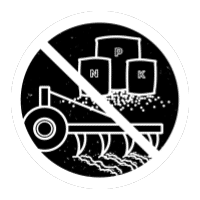Explore
Healing the Soil

What are regenerative agricultural (farming and gardening) practices, and how do they help the soil?
We have learned the hard way that tilling and using synthetic (chemical, man-made) pesticides and fertilizers harms the soil over time. Now, people are looking back to how people worked the land before these practices. Blending older traditional ways with today's innovative technologies and lessons learned, many people are embracing a new kind of agricultural approach called Regenerative Agriculture. These practices help people grow abundant, nutrient-rich crops and maintain healthy gardens, while also regenerating (restoring and reviving) the soil's natural ability to sequester carbon, store nutrients, air, and water, and support a diverse ecosystem of soil organisms.
Regenerative Agricultural Practices
Whether you're cultivating a large farm, planting a small garden, or simply growing one potted plant on your porch, using all of these practices together will help restore the health and biodiversity of your soil, increase its ability to sequester carbon and store water, and improve the health of nearby water resources.
Regenerative Agriculture Practice
Least Disturbance: No-Till
Leaving soil un-tilled and un-disturbed means that sequestered carbon can stay in the soil and that habitat for beneficial microorganisms is maintained. There are specialized no-till drills that can help plant seeds without breaking up soil structure.
Planting perennial crops along with annuals: Perennials are plants that can remain productive for more than one growing season or year. These plants’ hardy roots can sequester carbon for longer periods of time than annual crops, and can also help break up soil (like less destructive mini-tillers) as they grow.
Regenerative Agriculture Practice
Living Root: Compost. Use natural fertilizers and pesticides.
Natural fertilizers and pesticides: Stopping the use of chemical fertilizers and pesticides can give soil microorganisms and beneficial insects in your farm or garden a chance to thrive! Without these chemicals, plants can continue photosynthesizing, decomposing plant matter, and sequestering carbon. There are natural fertilizers farmers and gardeners can use, as well as many natural ways of preventing pests without the use of these harmful substances.
Composting: Any plant matter from the kitchen or from the farm has nutrients! Composting allows this matter to decompose into an easy-to-apply substance to spread over your soil so those nutrients return to the ground without having to use synthetic fertilizer.


Regenerative Agriculture Practice
Soil Armor: Reduce bare soil with cover crops and mulch
Bare soil releases more carbon from the ground and causes water to evaporate more quickly. Many farmers and gardeners leave their soil uncovered during the winter and in non-growing seasons, but this puts precious soil at risk of being washed away. Cover cropping (growing plants that return nutrients to the soil in these off-seasons) and mulching (using compost, straw, dead leaves or grass clippings to spread over soil and around plants during the growing season) can help avoid soil erosion, conserve water, and prevent nutrient loss, as well as stop carbon from being released back into the atmosphere.
Regenerative Agriculture Practice
Animal Integration: Manage livestock grazing
As plants are grazed by livestock, their top-growth is removed. Plants then need to use the carbon stored in their roots to regrow. If plants are grazed too much and too frequently (which happens in a conventional pasture) the plant will be unable to grow or store more carbon in their roots. By contrast, in a rotational or intensively managed pasture, animals are moved from field to field more often, so that plants can have a chance to regrow, stay healthy, and continue sequestering carbon. As they move from each field, livestock waste fertilizes each field more equally than if the animals were not being moved regularly. If a farmer or gardener has the space for livestock or raises them already, using management intensive grazing will ensure that soil and plants can stay healthy and continue thriving.


.Regenerative Agriculture Practice
Increased Biodiversity: Plant a wide variety of crops. Rotate crops.
Conventional agricultural practices include planting only one or two crops (also known as monoculture). This has a negative effect on soil nutrients, since as crops grow they use up nutrients from the soil - if only one or two crops are grown each year, the nutrients these crops use more of will be eventually lost from the soil. Along with cover cropping (planting crops that return nutrients to the soil) and composting, farmers and gardeners can plant a large array of crops each year (polyculture) and rotate where each is planted (crop rotation), so that soil nutrients are given a chance to replenish themselves. These methods also help to discourage crop-specific pests from taking over certain fields.
Traditional Indigenous Practices
Spot the Difference
Click on the arrows at the top or sides of the images to compare side-by-side photos of farms that use conventional agriculture with farms that use regenerative practices. Notice the differences between them. How do some practices help the soil while others harm it?
Complete your Plant Care Product Survey
Take a second look at your plant care products and equipment, and their effects on your soil. Use what you've learned about harmful and helpful practices to complete your Home Survey of Plant Care Products.

